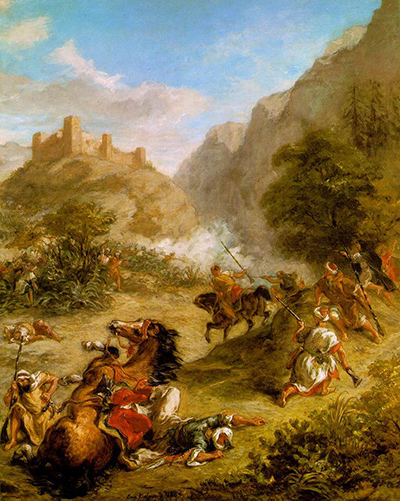Arabs Skirmishing in the Mountains was painted a few months before his death in 1863, but inspired by his visit to Morocco in 1832.
The composition takes the viewer straight into the dynamic of the imagined encounter. Energy moves upwards from left to right with mounting intensity - from the fallen rider and the struggling horse to the armed and attacking warriors. Then it is released, through the charging horsemen, down into the centre of the frame and the heart of the battle. Then the eye moves through the gun smoke and abruptly up to the castle on the hill and finally into the blue sky. The artist creates the physical and emotional sensations caused by a violent encounter in the mountains. His use of red, white and blue arrests the eye at each group, emphasising the violent rhythms of battle on horseback.
His fluid brush strokes fill the canvas with energy. In 1832, Delacroix had travelled to Spain and North Africa. He wanted to escape from Paris and hoped see a more primitive and vibrant culture. What he saw entranced him and inspired more than one hundred paintings and drawings. In these works, for example, Death of Sardanapalus, Massacre at Chios and Arabs Skirmishing in the Mountains, he followed in the footsteps of Michelangelo and Rubens by focussing on violent, epic subjects. His use of a lush palette and vibrant brush strokes was to influence Impressionism and Post Impressionism. Delacroix took the traditions of Michelangelo and Rubens and combined them with his own genius to create a new, dynamic, style of painting that, while rooted in the traditions of the past, opened the doors to the future.
Delacroix remains an extraordinary artist who bridged the gap between the old masters and more contemporary art, a little similar to how Cezanne would contribute some years later. He specialised in a number of genres, including historical paintings as well as depictions of horses and other items that were inspired by Romanticist literature, some of which came from the pen of Lord Byron. There was also a beautiful choice of colour within his career with some comparisons made with the Venetian Renaissance, with bright tones of red being particularly memorable.




